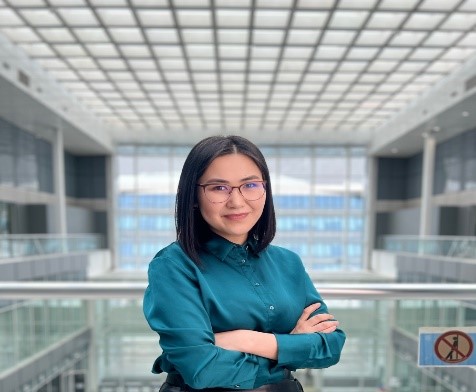The Belt and Road Initiative (BRI) is opening new horizons in socio-economic development and regional cooperation worldwide. This comprehensive project, particularly through its deep connections with countries in strategic positions such as Kazakhstan, showcases a broad spectrum of collaboration opportunities, ranging from trade to cultural exchange.
Based on this, the Ankara Center for Crisis and Policy Studies (ANKASAM) presents the opinions received from Dr. Ainur Slamgazhy, a faculty member at Astana Information Technologies University, to assess the regional and global impacts of the BRI.
1. What are your thoughts on the Belt and Road Initiative’s (BRI) potential for socio-economic development and promoting regional cooperation?
The Belt and Road Initiative presents a significant opportunity for socio-economic development and regional cooperation, particularly evident in the case of Kazakhstan. President Kassym-Jomart Tokayev’s recent agreements with China underscore the potential for leveraging Kazakhstan’s strategic geographical position to enhance trade, economic, and logistics connectivity.
The signing of agreements worth $22 billion during President Tokayev’s visit highlights the tangible economic benefits of Kazakhstan’s involvement in the BRI. Kazakhstan’s readiness to mobilize its economic and logistics potential further strengthens cooperation not only with China but also with other countries in the region. With trade between China and Kazakhstan already reaching $31 billion, and plans to increase it to $40 billion, there is clear momentum towards deeper economic ties.
Moreover, Kazakhstan’s role as a key player in Central Asia contributes significantly to the region’s economic growth. The increase in economic relations with neighboring Central Asian countries, coupled with the significant trade volume between Central Asia and China, exemplifies the BRI’s potential to foster regional economic integration.
President Tokayev’s proposal for a visa-free regime for tourists between China and Kazakhstan reflects the broader efforts to enhance people-to-people exchanges and cultural ties, further facilitating economic cooperation.
Overall, Kazakhstan’s active participation in the BRI underscores its commitment to harnessing the initiative’s potential for socio-economic development and promoting regional cooperation. With concerted efforts, there is a promising outlook for further enhancing trade turnover and economic integration between China, Kazakhstan, and the broader Central Asian region under the BRI framework.
2. How does China’s role in the global stage through the BRI affect the project’s international image and perception?
China’s role in the global stage through the BRI significantly influences the project’s international image and perception. Initially known for its infrastructure investments, the BRI has evolved into a platform for promoting China’s soft power and international image.
While the BRI is often associated with economic development, it aligns with China’s discourse of “Peaceful Rise,” presenting a non-coercive and non-military narrative that enhances China’s soft power potential, particularly in regions like Central Asia. As highlighted by Timur Dadabaev[i], the BRI serves as a means for China to project its image as a responsible global actor committed to mutual development and cooperation.
However, despite China’s efforts to promote the BRI internationally, studies, such as Primiano and Kudebayeva’s research in 2023[ii], indicate a lack of awareness among populations, particularly in countries like Kazakhstan. This lack of information can lead to misconceptions and negative perceptions of both the BRI and China’s involvement.
To address this issue, steps are being taken at both the state and grassroots levels. Initiatives like Confucius Institutes, student exchanges, and journalist internships in China contribute to citizen diplomacy and cultural exchanges. These efforts not only promote understanding but also help improve China’s image by showcasing its cultural richness and fostering people-to-people connections.
Furthermore, emphasizing cultural exchanges highlights the historical significance of the Silk Road, reminding people of the shared cultural heritage along these routes. By integrating cultural diplomacy into the BRI, China can enhance its international image and foster greater trust and cooperation among participating countries.
While challenges remain in terms of awareness and perception, China’s efforts to promote cultural exchanges and citizen diplomacy alongside infrastructure investments can positively shape the international image of the BRI and China’s global role.
3. What contributions do projects under the Belt and Road Initiative (BRI) make to the cultural and social structures of participating countries?
The recent flurry of projects under implementation following President Kassym-Jomart Tokayev’s visit and Minister Aida Balayeva’s diplomatic efforts underscores the significant momentum in cultural exchange between Kazakhstan and China. The agreement to establish equal cultural centers for both nations is a pivotal step towards fostering deeper cultural dialogue and cooperation. Minister Balayeva’s recent visit to China further catalyzed this cultural exchange, emphasizing the importance of returning archival materials and promoting collaborative initiatives such as master classes, grants for cinematography, and joint media productions.
Moreover, initiatives like the China International Press Communication Center organized by the China Public Diplomacy Association are facilitating practical cooperation between media organizations, enabling foreign journalists, including those from Kazakhstan, to gain a comprehensive understanding of China. The internship program at the China International Press Center provides an invaluable opportunity for correspondents to broadcast information from Beijing, fostering greater understanding of China’s culture and society.
These initiatives not only promote mutual understanding but also contribute to bridging cultural gaps and dispelling misunderstandings. By engaging in joint projects, sharing experiences, and facilitating cultural exchanges, Kazakhstan and China are forging stronger bonds and enriching their cultural landscapes. Ultimately, these efforts serve to strengthen bilateral relations and promote peace and cooperation between the two nations.
[i] “Silk Road” as foreign policy discourse: The construction of Chinese, Japanese and Korean engagement strategies in Central Asia”, Sagepub, https://journals.sagepub.com/doi/full/10.1016/j.euras.2017.12.003, (Access Date: 09.03.2024).
[ii] A Bumpy Ride for China’s Belt and Road Initiative in Kazakhstan: Findings from a University Survey”, Sagepub, https://journals.sagepub.com/doi/full/10.1177/18681026231211354, (Access Date: 09.03.2024).

